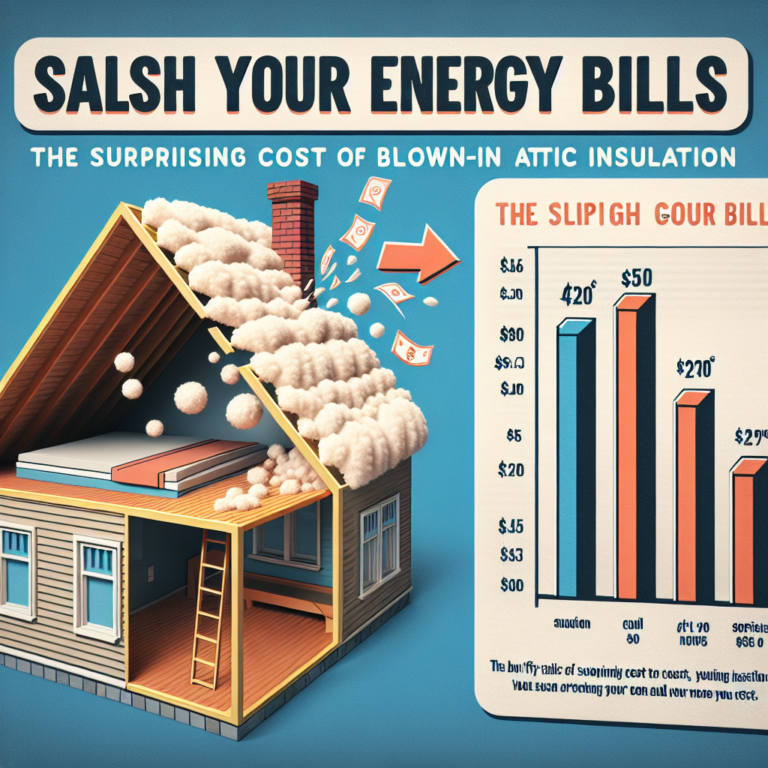-
Table of Contents
“Efficiently insulate your cathedral ceiling with blown-in insulation – keeping your home comfortable and energy efficient all year round.”
Introduction
Blown-in insulation is a popular method of insulating cathedral ceilings, which are characterized by their sloped or vaulted shape. This type of insulation involves using loose, lightweight materials such as fiberglass, cellulose, or mineral wool, which are blown into the ceiling cavity to create a thermal barrier. This method is often preferred for cathedral ceilings due to its ability to fill in hard-to-reach spaces and provide a more uniform coverage compared to traditional batt insulation. In this introduction, we will explore the benefits and considerations of using blown-in insulation for cathedral ceilings.
The Benefits of Blown-In Insulation for Cathedral Ceilings
Cathedral ceilings are a beautiful architectural feature that can add a sense of grandeur and spaciousness to any room. However, they also come with their own set of challenges when it comes to insulation. Traditional insulation methods, such as batt or roll insulation, can be difficult to install in cathedral ceilings due to their sloped and often inaccessible design. This is where blown-in insulation comes in as a highly effective and efficient solution for insulating cathedral ceilings.
Blown-in insulation, also known as loose-fill insulation, is made up of small particles of materials such as fiberglass, cellulose, or mineral wool. These particles are blown into the ceiling cavity using specialized equipment, filling in all the nooks and crannies and creating a seamless layer of insulation. This method of insulation is particularly well-suited for cathedral ceilings as it can easily conform to the shape of the ceiling and provide complete coverage.
One of the main benefits of blown-in insulation for cathedral ceilings is its ability to provide a high level of thermal resistance, also known as R-value. The R-value measures the insulation’s ability to resist heat flow, and the higher the R-value, the better the insulation’s performance. Blown-in insulation has a higher R-value per inch compared to traditional insulation methods, making it a more effective choice for cathedral ceilings where space is limited.
Another advantage of blown-in insulation for cathedral ceilings is its ability to create an airtight seal. As the particles are blown into the ceiling cavity, they fill in all the gaps and crevices, preventing any air leaks. This not only helps to maintain a consistent temperature inside the room but also reduces energy costs by preventing heat loss or gain. Additionally, an airtight seal can also help to reduce noise transmission, making your home more peaceful and comfortable.
One of the biggest challenges with insulating cathedral ceilings is the difficulty of installation. Traditional insulation methods require access to the ceiling cavity, which can be challenging and time-consuming, especially in older homes. Blown-in insulation, on the other hand, can be installed from the outside of the home, making it a much more convenient and efficient option. This also means that there is minimal disruption to your home during the installation process.
Furthermore, blown-in insulation is a more environmentally friendly option compared to traditional insulation methods. It is made from recycled materials and does not contain any harmful chemicals, making it a safe and sustainable choice for your home. Additionally, blown-in insulation has a longer lifespan compared to other types of insulation, reducing the need for frequent replacements and minimizing waste.
In addition to its practical benefits, blown-in insulation also offers aesthetic advantages for cathedral ceilings. As it is blown into the ceiling cavity, it can easily conform to the shape of the ceiling, creating a smooth and seamless finish. This means that there are no visible gaps or bulges, maintaining the beauty and integrity of your cathedral ceiling.
In conclusion, blown-in insulation is a highly effective and efficient solution for insulating cathedral ceilings. Its ability to provide a high R-value, create an airtight seal, and its convenience of installation make it a superior choice compared to traditional insulation methods. Not only does it offer practical benefits, but it also has aesthetic advantages, making it a well-rounded option for any homeowner looking to insulate their cathedral ceilings.
Factors Affecting the Cost of Blowing Insulation into Cathedral Ceilings

Blown-in insulation is a popular method for insulating cathedral ceilings, as it provides a cost-effective and efficient way to keep your home comfortable and energy-efficient. However, the cost of this insulation method can vary depending on several factors. In this article, we will discuss the factors that can affect the cost of blowing insulation into cathedral ceilings.
The first factor to consider is the type of insulation material used. Blown-in insulation can be made from various materials such as fiberglass, cellulose, and mineral wool. Each of these materials has its own cost, with fiberglass being the most affordable and mineral wool being the most expensive. The type of material used can significantly impact the overall cost of the insulation project.
Another factor that affects the cost is the size of the cathedral ceiling. The larger the area that needs to be insulated, the more material and labor will be required, resulting in a higher cost. Additionally, the height of the ceiling can also affect the cost, as it may require specialized equipment and additional labor to reach and insulate high ceilings.
The condition of the cathedral ceiling is also a crucial factor in determining the cost of blown-in insulation. If the ceiling is in good condition, the process of blowing in insulation will be relatively straightforward and less time-consuming, resulting in a lower cost. However, if the ceiling has existing damage or requires repairs, the cost of the project will increase as the repairs will need to be completed before the insulation can be installed.
The accessibility of the cathedral ceiling is another factor that can affect the cost. If the ceiling is easily accessible, the installation process will be more straightforward and less time-consuming, resulting in a lower cost. However, if the ceiling is difficult to access, such as in a multi-story home, it may require specialized equipment and additional labor, increasing the overall cost of the project.
The location of the home can also impact the cost of blown-in insulation into cathedral ceilings. The cost of labor and materials can vary depending on the region, with urban areas typically having higher costs than rural areas. Additionally, the climate of the region can also affect the cost, as homes in colder climates may require thicker insulation, resulting in a higher cost.
The complexity of the cathedral ceiling can also play a role in the cost of blown-in insulation. If the ceiling has intricate designs or features such as skylights, vents, or recessed lighting, it may require more time and effort to install the insulation, resulting in a higher cost. It is essential to consider these factors when estimating the cost of blown-in insulation for a cathedral ceiling.
Lastly, the cost of blown-in insulation into cathedral ceilings can also be affected by the contractor you choose. It is crucial to research and compare quotes from different contractors to ensure you are getting the best price for the project. It is also essential to choose a reputable and experienced contractor to ensure the insulation is installed correctly and efficiently.
In conclusion, several factors can affect the cost of blowing insulation into cathedral ceilings. The type of insulation material, the size and condition of the ceiling, accessibility, location, complexity, and the contractor you choose can all impact the overall cost of the project. It is essential to consider these factors and do thorough research to ensure you are getting the best value for your money. With proper planning and consideration, blown-in insulation can be a cost-effective and efficient way to insulate your cathedral ceiling and improve the comfort and energy efficiency of your home.
Comparing Blown-In Insulation Options for Cathedral Ceilings: Fiberglass vs. Cellulose
When it comes to insulating a cathedral ceiling, there are two main options to consider: fiberglass and cellulose blown-in insulation. Both of these materials have their own unique properties and benefits, and it’s important to understand the differences between them in order to make an informed decision for your home.
Fiberglass blown-in insulation is made up of tiny glass fibers that are blown into the ceiling cavity using a special machine. This type of insulation is known for its high R-value, which measures the material’s ability to resist heat flow. Fiberglass has an R-value of around 2.2-2.7 per inch, making it a very effective insulator for cathedral ceilings.
One of the main advantages of fiberglass blown-in insulation is its durability. It is resistant to moisture, mold, and pests, making it a long-lasting option for your cathedral ceiling. Additionally, fiberglass is non-combustible, meaning it will not catch fire or contribute to the spread of flames in the event of a fire.
However, there are some downsides to using fiberglass blown-in insulation. One of the main concerns is the potential for air leakage. If the insulation is not installed properly, gaps can form between the fibers, allowing air to pass through and reducing its effectiveness. This can also lead to higher energy bills and a less comfortable living space.
Another factor to consider is the potential health hazards associated with fiberglass insulation. The tiny glass fibers can irritate the skin, eyes, and respiratory system if inhaled. While proper installation and handling can minimize these risks, it is still important to take precautions when working with fiberglass insulation.
On the other hand, cellulose blown-in insulation is made from recycled paper products, such as newspapers and cardboard. It is treated with fire-retardant chemicals to make it safe for use in homes. Cellulose has a slightly lower R-value than fiberglass, ranging from 3.2-3.8 per inch. However, it is still a very effective insulator for cathedral ceilings.
One of the main advantages of cellulose insulation is its ability to fill small gaps and crevices, providing a more complete coverage than fiberglass. This can help to reduce air leakage and improve the overall energy efficiency of your home. Additionally, cellulose is a more eco-friendly option, as it is made from recycled materials.
However, there are some concerns with using cellulose blown-in insulation as well. One of the main issues is its potential to settle over time, which can reduce its effectiveness. This can be mitigated by using a higher density of cellulose, but it may also increase the cost of installation.
Another factor to consider is the potential for mold growth. Cellulose is made from organic materials, which can provide a food source for mold if it becomes wet. Proper installation and moisture control measures can help to prevent this issue, but it is still something to be aware of.
In conclusion, both fiberglass and cellulose blown-in insulation have their own unique properties and benefits for insulating a cathedral ceiling. Fiberglass is known for its durability and high R-value, while cellulose is more eco-friendly and can provide better coverage. Ultimately, the best option for your home will depend on your specific needs and budget. It is important to consult with a professional insulation contractor to determine the best choice for your cathedral ceiling.
Q&A
Q: What is blown in insulation?
A: Blown in insulation is a type of insulation material that is installed by blowing it into a space, such as a wall or attic, using specialized equipment.
Q: How is blown in insulation installed in a cathedral ceiling?
A: Blown in insulation can be installed in a cathedral ceiling by accessing the space through small holes drilled in the ceiling, and then using a blower to distribute the insulation evenly throughout the space.
Q: What are the benefits of using blown in insulation in a cathedral ceiling?
A: Blown in insulation can help improve the energy efficiency of a home by reducing heat loss and air leakage through the ceiling. It can also help with soundproofing and can be a more cost-effective option compared to traditional insulation methods.
Conclusion
In conclusion, blown-in insulation is a highly effective and efficient method for insulating cathedral ceilings. It provides excellent coverage and can easily fill in any gaps or crevices, ensuring maximum energy efficiency and comfort in the home. Additionally, blown-in insulation is a cost-effective option and can be installed quickly and easily. Overall, it is a great choice for homeowners looking to improve the insulation of their cathedral ceilings.






